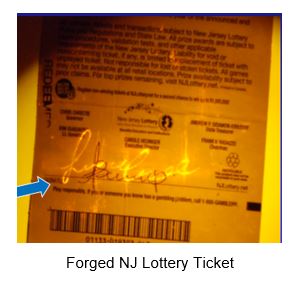Trace Evidence Analysis
Trace Evidence Analysis is the discipline of forensic science that deals with the minute transfers of materials that cannot be seen with the unaided eye. The handling and analysis of trace evidence requires care and specialized techniques. Trace evidence may provide a link between the victim and a suspect, a victim and a scene, or the suspect and a scene.
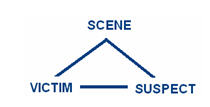
The significance of trace evidence is often overlooked, however, in the absence of probative biological evidence, trace evidence may be the only source that can provide crucial investigative information.
For evidence submittal to the Trace Evidence Unit, see the Evidence Field Manual link on the OFS home page.
The accredited areas within Trace Evidence Analysis can be divided into eleven sub-disciplines:
- Fire Debris Analysis
- Glass
- Gunshot Residue
- Hair ID
- Impressions
- Lightbulbs/Filaments
- Low Explosives
- Paint
- Physical Fits
- Plastic Bags
- Pressure Sensitive Tape
The Trace Evidence Unit can also provide testing not covered under our scope of accreditation in the following areas:
Scientists also provide crime scene examination and reconstruction and training to the law enforcement agencies within the State of New Jersey.
Fire Debris Analysis

Paint Cans
Fire Debris Analysis involves the determination of whether or not added ignitable liquid residues are present in samples obtained from fires. The samples are submitted for analysis in airtight containers, usually paint cans for solid debris, or in mason jars for liquid samples.
These samples are tested for ignitable liquid residues using two main methods, heated headspace and passive headspace. Heated headspace involves the heating of the sample to allow any residues present to vaporize into the headspace, or area above the debris, in the can. It is then removed using a syringe and injected into a gas chromatograph.
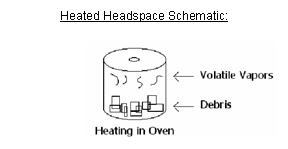
Passive headspace also involves heating the sample, but this time for a longer period of time, and with the use of a carbon strip for concentration. Any residues present vaporize into the headspace and adsorb to the carbon strip. The strip is then eluted with a solvent and injected into the gas chromatograph / mass selective detector (GC/MSD).
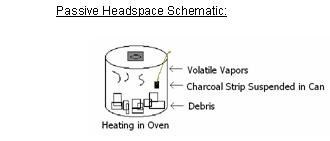
The results of the chromatographic analysis, or the resulting chromatograms, are interpreted by the analyst to determine which, if any, ignitable liquid resides are present in the sample. The most commonly used accelerant is gasoline, due to its accessibility and relatively low cost.
Glass Analysis
There are many cases in which glass plays an important role e.g. breaking and entering, hit and run, vandalism, or murder.
 During the course of analysis, the glass analyst will ask themselves the following questions:
During the course of analysis, the glass analyst will ask themselves the following questions:
- Are the fragments submitted as glass, actually glass?
- Did this person break this window?
- Do the submitted fragments match the known sample?
- Do the fragments recovered from the suspect, come from more than one source?
- How common is it to find glass on someone unrelated to the crime?
- Which direction was the window broken?
- What broke the window?
- Which shot was first and from which direction did it originate?
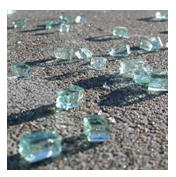 To determine the answers to these questions, the analyst will employ different procedures to test the sample. They will confirm the presence of glass by: pressing the sample with a sharp object, using a polarizing microscope to determine its optical properties, and attempting to dissolve the sample in water. Next they will observe the class characteristics of both the questioned and the known sample to determine if a comparison is possible. Characteristics such as color, clarity, surface characteristics, thickness, and fluorescence are observed for both the questioned and the known sample. If the analyst determines that there are no obvious physical differences between the two, the refractive indices of each will be measured.
To determine the answers to these questions, the analyst will employ different procedures to test the sample. They will confirm the presence of glass by: pressing the sample with a sharp object, using a polarizing microscope to determine its optical properties, and attempting to dissolve the sample in water. Next they will observe the class characteristics of both the questioned and the known sample to determine if a comparison is possible. Characteristics such as color, clarity, surface characteristics, thickness, and fluorescence are observed for both the questioned and the known sample. If the analyst determines that there are no obvious physical differences between the two, the refractive indices of each will be measured.
The refractive index will be determined using a Glass Refractive Index Measurement System (GRIM by Foster and Freeman). It is based on the results of this test that the analyst concludes whether or not the two pieces of glass could have a common origin.
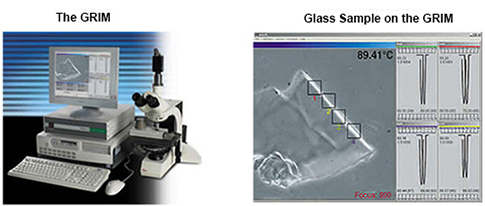
Gunshot Residue Analysis
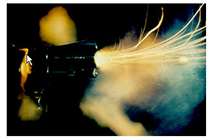 Gunshot residue analysis determines whether the damage produced on the item of evidence was caused by a firearm, and if so, how far the shooter was from the object / person. In certain instances, it is also possible to determine the type of firearm used.
Gunshot residue analysis determines whether the damage produced on the item of evidence was caused by a firearm, and if so, how far the shooter was from the object / person. In certain instances, it is also possible to determine the type of firearm used.
In analyzing items for gunshot residue, the analyst follows the following procedure:
- Macroscopic Examination
- Microscopic Examination
- Chemical Tests
Macroscopic examination involves looking at the item of evidence without any visual aid and describing the area in question, such as any rips and tears that may be present.
 If a contact shot (muzzle touching / almost touching object / person) was fired, the pattern on the item of clothing will have a characteristic “cruciform” tear (see photo at left).
If a contact shot (muzzle touching / almost touching object / person) was fired, the pattern on the item of clothing will have a characteristic “cruciform” tear (see photo at left).
Microscopic examination involves looking at the areas in question under a microscope and noting any gunpowder or other residues, such as sooting or blackening.
Chemical tests indicate the presence of nitrites, copper, and lead on the item.
| CHEMICAL TEST | INDICATES PRESENCE OF |
POSITIVE COLOR |
| Griess Test | Nitrites | Orange |
| Dithiooxamide (DTO) | Copper | Green |
| Sodium Rhodizonate | Lead | Purple |
Below are sample chemical test results:
(Photos Courtesy of Firearms ID)

The approximate distance from the shooter to the object / person can be determined when a suspect firearm is submitted. This type of testing is done in conjunction with our Ballistics Unit, which conducts test fires using the suspect firearm and the type of ammunition used during the crime. These test fires are done at varying distances and are processed for residues by the analyst. The members of the Ballistics Unit work together with Trace Evidence analyst to determine a distance range using the pattern of nitrites present.
Hair ID
It is not uncommon for people to shed hair throughout the course of the day. The ease of transfer of this type of evidence makes it useful in criminal investigation. Forensic testing of hairs involves identification of human versus animal hair and suitability for Nuclear DNA Analysis.
Hair ID Analysis Can Determine:
- Species
- Color
- Body Area
- Tip (Cut, Broken, Split)
- Method of Removal
- Disease
- Race
- Length
- Diameter
- Artificial Treatment (Dying/Bleaching)
- Damage (Crushed, Broken, Burned)
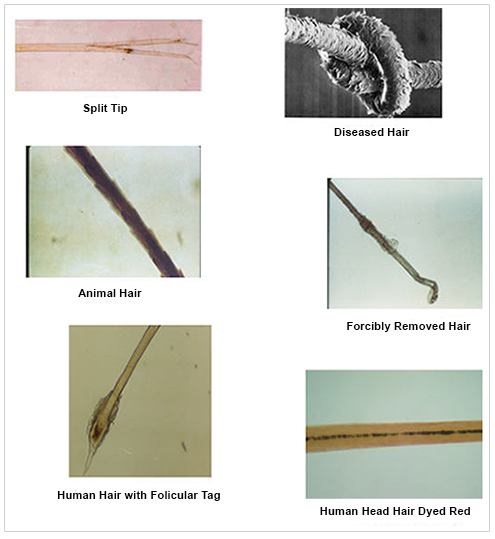
Impressions Analysis
Impression evidence involves the interaction of two or more surfaces or objects in a manner that either leaves a mark on the other or removes a portion of the surface of one or both. Impressions are formed by the contact and retention of characteristics from each of these objects. Impressions analysis can be broken down into four topics: footwear, tire, toolmarks and miscellaneous.
Footwear Impressions
Footwear impressions are often discovered at the scene of the crime. This evidence can provide investigators with certain information that can assist them in locating a suspect. Most footwear evidence, when collected and preserved properly, can provide the type of footwear, manufacturer, approximate size, number of suspects, path through and away from the crime scene, involvement of the evidence, and events that occurred during the commission of the crime.
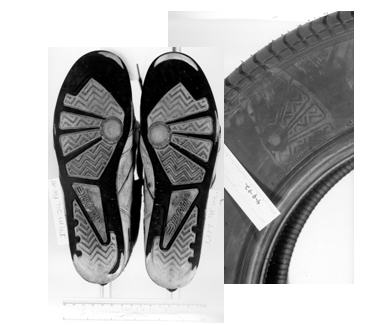
Analysis of a footwear impression may include comparing a suspect’s shoe to either photographs or castings made of dental stone (similar to plaster of paris).
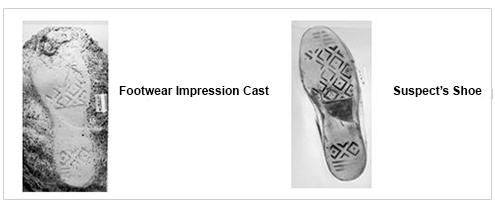
When individual detail is present, it is possible to individualize an impression to a specific shoe.
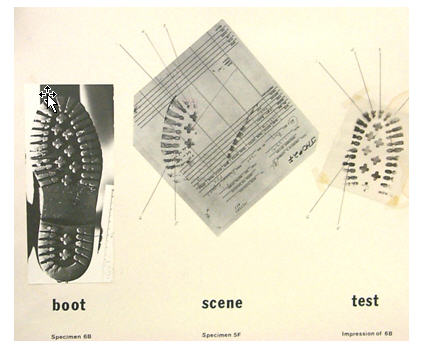
Footwear evidence can be found in two forms, impressions and prints. The impression is normally described as a three-dimensional impression, such as an impression in mud or a soft material, while the print may be made on a hard surface by dust, powder, or similar medium.
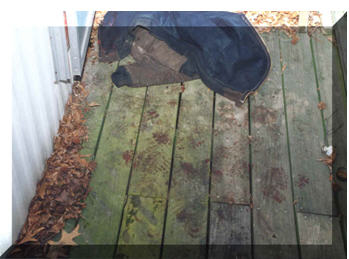
Photography Courtesy of: www.forensicconsult.com
Tire Impressions
 Tire impressions are a significant source of evidence, dictating who went to and from the crime scene. When tires are received for comparison, test impressions are normally made to aid the analyst. As in the case of footwear impressions, when individual detail is present between the known tires and the impressions received from the scene, it is possible to individualize an impression to a specific tire.
Tire impressions are a significant source of evidence, dictating who went to and from the crime scene. When tires are received for comparison, test impressions are normally made to aid the analyst. As in the case of footwear impressions, when individual detail is present between the known tires and the impressions received from the scene, it is possible to individualize an impression to a specific tire.
In looking at tire impressions, the analyst will note:
- Manufacturer’s Design
- Size
- Wear Patterns
- Any Individual Characteristics Present
- Arrangement of the Tires on the Suspect’s Vehicle
- Arrangement of Tires Established at the Crime Scene
- Number of Grooves
- Tread Design
- Other Individualizing Characteristics
Tire impressions found at the crime scene can be submitted as plaster casts, photographs, electrostatic lifts, or as impressions on paper or cardboard.
Miscellaneous Impressions
Miscellaneous impressions are most commonly found in cases of breaking and entering, theft, hit & runs, assault, and homicide. The goal of this analysis is to determine if a particular item may have left a particular mark. Due to manufacturing processes and wear from use, certain items may start to bear unique microscopic characteristics, allowing the impression they leave to be positively associated back to the originating item.
Common Item that can leave impressions:
- Gloves
- Clothing
- Fabric
- Rope
- Ligatures
- Bullet Strikes
Miscellaneous impressions found at the crime scene can be submitted as 1:1 photographs, electrostatic lifts, tape lifts or if practicable the entire original item with the question impressions.
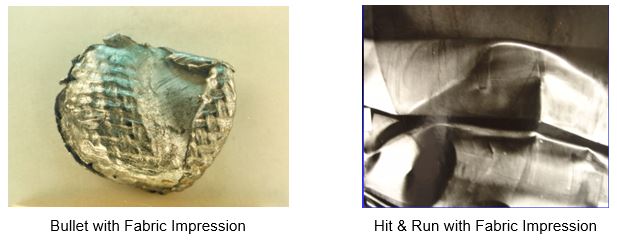
Lightbulb/Filament Examinations
Forensic examination of lightbulb/filaments can assist investigations by determining whether the lightbulb/filament was “on” or “off” at the time of impact. This can corroborate or refute the scenarios presented to the investigators as to whether the victim should have been able to see the vehicle coming in the case of a hit and run, or whether the driver was signaling a turn when they were involved in a motor vehicle accident with a driver who states that they didn’t see a signal.
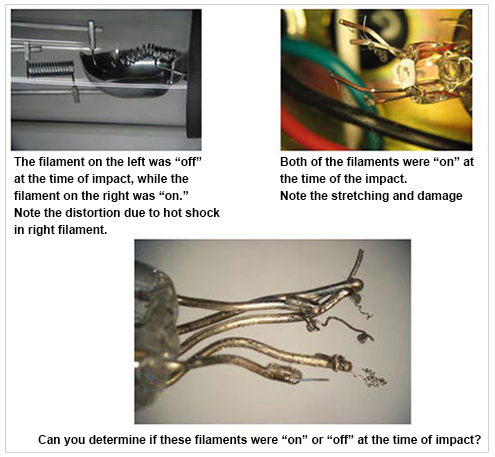
Low Explosives
Criminal activity involving explosives are a threat to public safety. Unsuspecting bystanders could fall victim and be harmed by the discharged chemicals or materials contained in the explosive device. Forensic testing analyzes the material that comprises the device including the containment unit and the harmful chemicals within it. In some cases, homemade explosives could be identified and traced back to the criminal.
By definition, low explosives deflagrate, unlike high explosives, which detonate, making them able to be analyzed in the laboratory. Before any explosive is submitted to the laboratory, however, it must be rendered safe by the New Jersey State Police Arson / Bomb Unit or a Certified Member of the NJ Render Safe Task Force
Common Types of Low Explosives:
- Black Powder
- Flash Powder
- Smokeless Gunpowder
- Pyrotechnic Mixtures
- Tear Gas or Pepper Spray
- Match Heads
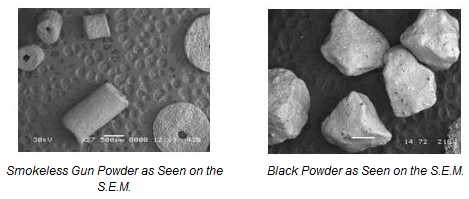
When Analyzing Low Explosive Items, Either Pre- or Post- Blast:
- Perform Macroscopic and Microscopic Examination (Fragments / Mechanism Itself)
- Determine Device Size and Type
- Type of Low Explosive Submitted (Black Powder / Smokeless Gunpowder, etc.)
- Weight of Low Explosive Submitted
- Ignition Susceptibility Test (Determine if Sample Ignites)
- Chemical Tests (Nitrates, Chlorates, Perchlorates)
- Elemental Analysis (XRD, SEM / EDS, FT-IR)
Common types of explosive evidence received are powders, pipe bombs, and chemical reaction bombs.
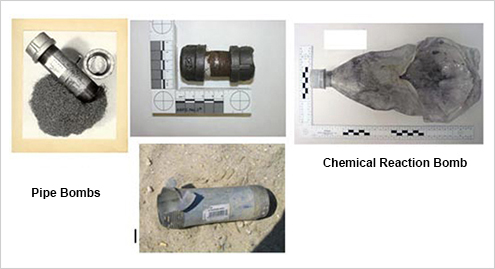
Paint
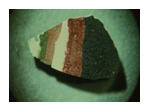
Layered Paint Chip
Paint evidence can be highly significant in cases involving either automotive or architectural paint. Paint transfer from a vehicle to a struck pedestrian may be the only source of evidence linking the suspect to the crime scene. Forensic paint analysis begins with collection of the paint evidence and stereomicroscopic observation of the nature of the paint samples (e.g., color and texture). It is important to determine if a physical fit may be possible between known and questioned samples, as well as documenting obvious areas where there may be differences, such as in color or number of layers present.
Instrumentation is then used to determine the chemical and physical properties that can distinguish between the many kinds of manufactured paints. Color similarities can be verified between known and questioned samples using the microspectrophotometer, while organic components can be identified using Fourier Transform Infrared Spectrometry (FT-IR) or Pyrolysis Gas Chromatography / Mass Spectrometry (Pyro-GC / MS). Inorganic components can be identified using the Scanning Electron Microscope (SEM / EDS). Any destructive techniques that may be performed are done on the basis of available sample size (i.e. – solvent tests, Pyro-GC / MS).
The analysis of plastics and polymers are also included in paint analysis because the scientific testing and evaluation involved in both are similar to one another.
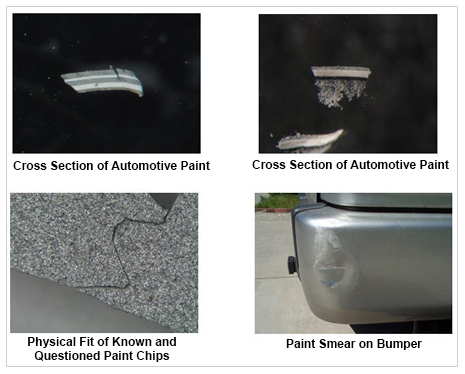
Physical Fit Analysis
Items being submitted for physical fit analysis include a variety of materials. When a material having reasonable rigidity breaks, irregularities appear at the break which may create pieces analogous to those of a “jigsaw puzzle.” Other types of materials may be subjected to separation by cutting, tearing, shattering, etc. When pieces are matched that can be physically fit together, the examiner can say with absolute certainty that the matching pieces were at one time a single unit.
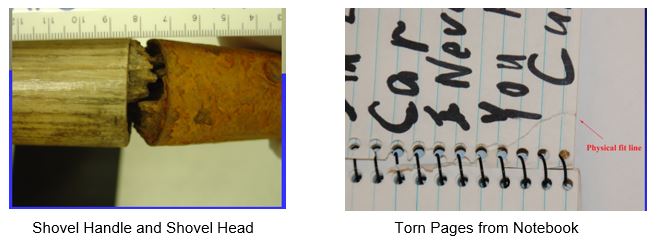
Plastic Bag Comparisons
Plastic bags are often used in connection with criminal activity to conceal or transport bodies or other forms of evidence.
The laboratory looks at characteristics formed during the manufacturing process. The known and questioned bags are examined next to each other using a light box or large window noting the following characteristics:
Class Characteristics:
- Size
- Type
- Type of Fold
- Dimensions of Fold
- Locations of Fold
- Perforations
- Color
- Degree of Clarity
- Pigment Bands
- Hairline Marks
Individual Characteristics:
- Variations in Thickness of Film
- Striations (i.e. - wood grain appearance)
- Cuts
- Tears
- Stretch Marks
- Location of Perforations

Bags whose class characteristics are not consistent do not compare, where as those bags whose class characteristics compare are then examined for individual characteristics. If individual characteristics are present and the bags can be physically fit together, it can be stated that they were originally a single unit. It is not always possible to definitively determine that the known and questioned were once a single unit, but the questioned may not have significant differences that would exclude them as a source either.
Pressure Sensitive Tape Comparisons
Tape is commonly received in the laboratory after being used as a means to bind victims, whether during the course of a home invasion, robbery, or homicide. Using visual and analytical methods, it is possible to determine if the unknown tape was once part of the roll containing the known tape. The following class and individual characteristics are observed:
Class Characteristics:
- Type (duct, masking, electrical, etc.)
- Color
- Width Measurement
- Type and Color of Adhesive
- Texture
Individual Characteristics:
- Cut or Tear Contour
- Teeth Marks
- Variations in Thickness
- Striations
During the course of analysis, the tape pieces are laid out flat, adhesive side down, on sheets of glass or microscope slides. The ends of the tape are examined macroscopically and a physical fit is attempted, if feasible, with the end of the roll of known tape submitted. If a physical fit appears to be present, it is confirmed microscopically and documented photographically.
Instrumentation used in tape comparison analysis is Fourier Transform Infrared Spectrometry (FT-IR) and Pyrolysis Gas Chromatography / Mass Spectrometry (Pyro-GC / MS), if sample size permits. For comparison purposes, both the backing and adhesive portions of the tape and are run on the FT-IR.

Fibers
Clothing fibers can be easily transferred simply by physically brushing across another object, like a chair, or another type of fabric. This type of transfer of fibers between victim, suspect, and scene is not uncommon. During the commission of violent crimes, especially, there is a greater likelihood that fiber evidence will be left behind.
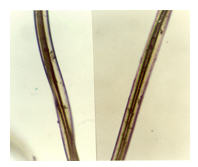
Fiber Comparison
Using Microscope
Fibers can be identified as natural (such as cotton, wool, or silk) or man- made (such as acrylic, nylon, or polyester), using polarized light microscopy (PLM) and Fourier Transform Infrared Spectrometry (FT- IR). Other fiber characteristics examined include color and cross-sectional shape.
In analyzing fiber evidence, several instruments are used:
- Stereomicroscope
- Comparison Microscope
- Polarized Light Microscope
- FT-IR
- Microspectrophotometer
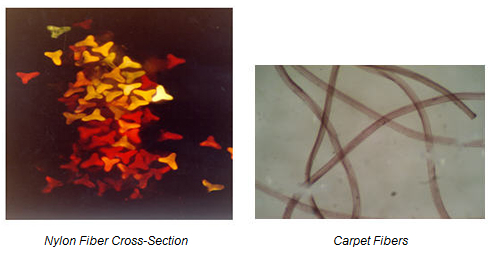

Cross-Sections of Nylon Carpet Fibers Run on the Scanning Electron Microscope
(Two Photographs Above Courtesy of www.fbi.gov/hq/lab)
Inks & Dye Analysis
Forensic cases involving inks and dyes can include forgery, terroristic threats, and bank robbery. A question ink or dye sample is analyzed using a scientific approach to identify the components within the substance and to determine if they can be associated to a known source.
